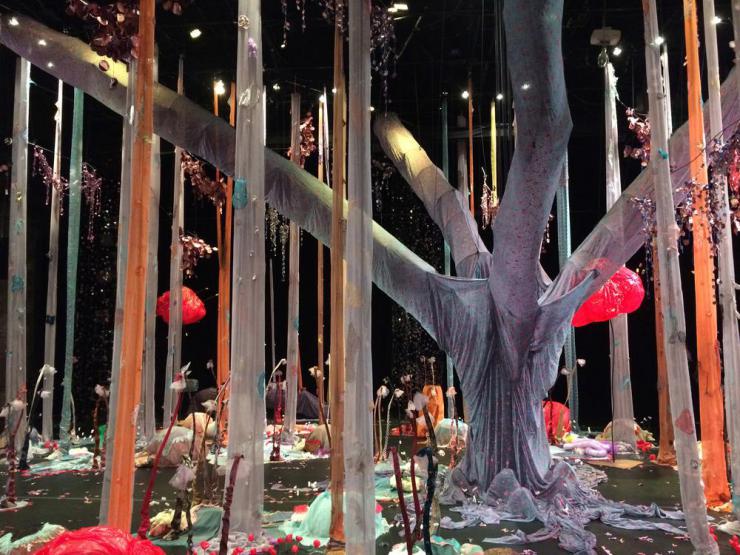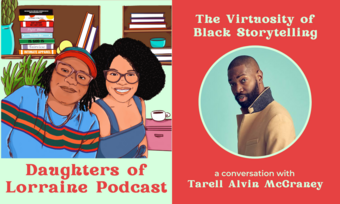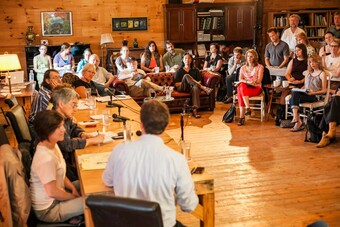The Psychology of the Audience
The Rules of Engagement
Seeking insight into what makes immersive theatre work for an audience, Jeffrey Mosser observes three productions: PearlDamour’s How to Build a Forest, Punchdrunk’s Sleep No More, and Mikhael Tara Garver’s Fornicated From the Beatles. The series includes interviews with creators as well as with patrons pre and post show. This is the final post of the series. Find the full series here.
Over the eight hours of How to Build a Forest audience engagement was varied. As mentioned in my previous post, I sat on stage briefly while the forest grew. The “Builders” had a goal, and worked around me; I never got the feeling that they were “acting”—or that there was any sense of urgency. Every member of the Forest cast was present. In addition, Builders would occasionally come into the audience and open up a conversation by describing what was happening on stage. The Builder’s description would segue into a question for the audience and a personal story. The Builder would always end with “Well, I’d better get back to work.”

I saw audience members open up with questions or stories of their own—this format always provided an opportunity for the patrons to participate. There was also audience engagement through what I would call a “passive flash mob”—ordinarily clothed actors slowly surrounded certain audience members and began to speak a scripted text. These “passive flash mobs” sounded much like an inner monologue. Their words made me think about how my point of view on the production might vary wildly from another’s, depending on what we each took in.
When I asked patrons whether or not How to Build a Forest was theatre they stumbled. “It is visual art and sculpture, but it is also choreographed” and “it’s performance art, but the actors engage you… there is a different way that theatre can be done successfully.” I followed up with, “What element do we need more of to make this more of a theatre piece?” Responses mostly entailed how many rules were applied; that traditional theatre was more governed than this piece. Then again some people said it was less governed (which I think says a great deal about the individual’s approach to all theatre). However, one patron indicated that less was more: “There was something about it not being permanent that made it a successful performance.”
I saw audience members open up with questions or stories of their own—this format always provided an opportunity for the patrons to participate.
It is worthy to note that audience members overwhelmingly felt their presence necessary to the show. Among other reasons, one enthusiastic participant noted, “I found myself standing, and maybe I was blocking the audience so yes, my blocking them was a part of the show. I was directly experiencing it.” As well as, “You become a part [of it]. You are not [in] a museum.”
Final Discovery: For immersive theatre makers, the audience comes first. Amongst the immersive theatre creators I spoke with, it was unanimous—the audience comes first. I might add that the most successful immersive theatre thinks about its audience from beginning to end—how they’re invite in, how they’re engaged, and the degree of their importance to the performance. “You can't jump to engagement before asking people to walk that bridge with you,” offers Katie Pearl of PearlDamour. “We don't know what people are coming in with, but we’re providing different doorways for people to come in through.” It’s with this in mind that I offer a set of rules based on my discoveries throughout this process. As in improvisation, you have to know the rules before you can break them—and once you break them let me know, because I’d like to see your show!
Rule #1: The audience is number one. And number two… and whatever your last number is.
Rule #2: Show the audience your relationships. Recognizing a relationship, even if it is veiled, makes an audience feel smart. Conversely, not seeing a relationship makes them feel like they’ve missed out— especially when it comes to their own relationship to the actor(s). There are three kinds of relationships in all theatre: actor/actor, actor/audience, and audience/audience. Nurture them all—or only those as you see necessary. No matter what you nurture, know that if the audience doesn’t get it, they won’t care about your show. (This goes for non-immersive theatre too.)
Rule #3: Give the audience the rules immediately. Even before the show if you can. You may want to keep a surprise up your sleeve, but be careful with what you withhold. An audience’s first reaction to participation is (frequently) resistance. Don’t build yourself a roadblock.
Rule #4: The audience chooses to engage. Regardless of how linear or non-linear your production is, be sure that your framework allows the audience to choose their degree of participation. If participation is vital to your show, don’t worry—the cream will rise to the top—but have a backup plan, and make sure the other aspects of the production are conducive to whichever end of the scale you’re seeking. For example, if your goal is to have the audience witness something, don’t make them participate at that moment as it may divide their attention. All necessary onuses should be removed from the audience.
Rule #5: Get ready for “that guy” in your audience. “This show eliminated my social graces—and since they were actors I felt like I didn’t have to be my real self either,” – patron post-show. There will always be someone whose personality is bigger than the scene being created. This person offers more to the show than you might want, pulling focus onto themselves. While you might think this guy should head back to the Medieval Times Dinner, if handled correctly, after the show “that guy” will be your best word of mouth. To some extent, degrees of “that guy” syndrome (i.e. bullying/egomania) can be eliminated when the show’s parameters are clearly set from the beginning.
Rule #6: You want to see some immersive/site-specific theatre? Go to the theatre! Now that’s meta. Creators, ask yourself: “can this story be told on stage?” If the answer is yes, what are you hoping to accomplish by putting it elsewhere? The trick is to keep the show from being gimmicky—and that comes with making the site/immersion absolutely necessary to telling the story. And for those of you thinking that site-specific creation is the next wave of theatre, I will remind you that we have built very specific spaces dedicated to the telling of stories—these spaces are called theatres and are true bastions of story telling—that will never change.
Rule #7: The fourth wall. I haven’t seen an immersive show yet that has the fourth wall. I have seen several site-specific shows that have it. If your fourth wall is going to come and go, it’s best to show the audience right away. (See Rule #3.)
Rule #8: Inauthenticity will kill audience buy-in. In my opinion, the best immersive theatre performers fall somewhere between improviser, clown, and stage manager. They have a keen understanding of the show’s structure and scene’s objective, and layered on top of that an openness and acceptance of what might happen at any point in time. If I can’t believe you are who you say you are on stage, then I’m second-guessing every aspect of the production—the audience always knows when you’re faking it. I guess what I'm saying is, the best performers I encountered had no ego.
Rule #9: Actors are the gateway to audience participation. You can invite the audience to touch things or participate until you’re blue in the face, but it’s up to the actors to open the doors for participation.
Rule #10: Immersive creation doesn’t follow any one formula. Perhaps it is a bit idealistic, but there is no one way to create an immersive piece. You have to decide which scale you want to land on and compromise the rest. The story is linear/nonlinear; the audience is a participant/voyeur; their reactions are crucial/inconsequential; and so on. Immersive theatre is created hanging in a delicate balance. There is no singular way to make this kind of work and it would be a shame to create some sort of formula for success. In the end, I found that while the greatest difference between traditional theatre and immersive theatre is what the audience is thinking, it’s what the performers are thinking about the audience that makes it truly successful. But that’s another blog.
Special thanks to: Countless audience members from West 27th Street to Chapel Drive, Lisa D’Amour, Duke University, Mikhael Tara Garver, the HowlRound crew, Katie Pearl, and the Alli Engelsma Mosser Charitable Foundation for a small “See Theater Without Me” grant.












Comments
The article is just the start of the conversation—we want to know what you think about this subject, too! HowlRound is a space for knowledge-sharing, and we welcome spirited, thoughtful, and on-topic dialogue. Find our full comments policy here
Another great article succinct and true rules!
http://www.guardian.co.uk/c...
Jeffrey -- Thanks so much for this series. I'll admit my biases, being one of the folks who brought How to Build a Forest to Duke, but I think this list of "rules" is a wonderful entry point into multiple conversations about the making and encounter of immersive theater, esp. a piece that tackles some complex inter and intra-disciplinary questions about both subject and form. I'm not sure if I've embedded this link into a previous comment on your series, but PearlDamour created a wonderful "Statement of Core Values" for patrons that can be found on the website we built for the residency http://sites.duke.edu/howto... That document touches on a # of your points in very piece-specific ways.
Thanks, Jules -- seeing Forest at Duke was very rewarding -- and thanks for the Core Values. I didn't know that this PDF existed! Awesome thoughts. This is a small world. Let's keep the conversation going!
Great job! I love this series. :)